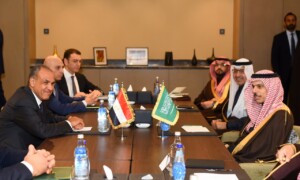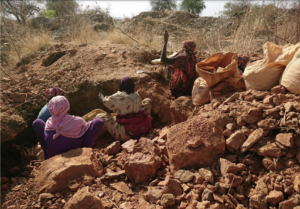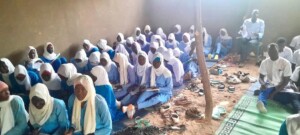Sudan’s Minister of Irrigation: Grand Ethiopian Renaissance Dam talks conclude
Sudan’s Minister of Irrigation and Water Resources Yasir Abbas has announced the conclusion of the current round of negotiations between Sudan, Ethiopia, and Egypt on the Grand Ethiopian Renaissance Dam (GERD), which on July 3 under the supervision of the African Union and the participation of international observers.
 Grand Ethiopian Renaissance Dam (GERD) under construction (Picture: MoFA Ethiopia)
Grand Ethiopian Renaissance Dam (GERD) under construction (Picture: MoFA Ethiopia)
Sudan’s Minister of Irrigation and Water Resources Yasir Abbas has announced the conclusion of the current round of negotiations between Sudan, Ethiopia, and Egypt on the Grand Ethiopian Renaissance Dam (GERD), which started on July 3 under the supervision of the African Union and the participation of international observers.
The Irrigation Minister noted in a press conference in the Sudan News Agency (SUNA) Forum on Monday evening, that the final report of this round will be submitted to the African Union on Tuesday, indicating that, as directed by the African Union, a mini-summit will be held after a week of submission of the report to start the next step.
Abbas explained the negotiations map, and the meetings held during the current round, noting to the start of this round on July 3 and continued until today, Monday, evening, stating that the map has included nine major negotiating rounds and six negotiating rounds in the technical and legal tracks.
Three rounds of meetings were held between the observers and the delegations of the three countries separately, indicating great keenness of the three countries’ delegations to reach an agreement on the outstanding points.
The minister pointed to four or five sticking points in the technical track, in addition to three outstanding main points in the legal side, and other points which he described as small in the legal side.
The main outstanding points in the technical side are the size of the daily flows change in the GERD that enters the Rusaires Dam, indicating the necessity of limited change in the daily flows for the safe operation of the Rusaires Dam, noting proposals were presented in this aspect with a limited rapprochement as the Sudan has agreed on 250 cubic meters, and Ethiopia on 350 cubic meters for the volume of flows. The sticking points in the technical track include the definition of the continuous operating curve of the GERD, which is necessary for the future planning of the Roseires Dam in Blue Nile state, noting to a limited rapprochement on this point.
He added: “Another sticking point is the re-filling of the GERD in the future’s droughts, in addition to another point that deals with the flows in the years of prolonged drought.”
The Irrigation Minister pointed out that the outstanding points in the legal aspects are the extent of the agreement obligation and whether it is concerned with the water sharing in addition to the disputes’ settlement mechanism, noting to the Sudan’s several balanced concordant proposals, indicating that the Sudan’s geographical location qualifies it to present these consensual proposals, stressing that Sudan is an original party in the GERD negotiations.
He added that the final report will be submitted tomorrow, Tuesday, which includes the Sudan’s stance, and a proposed scenario for an agreement that is based on the Sudan’s agreement concluded on June 14, with the amendments made to be added to it.
As previously reported by Radio Dabanga, Sudan, Ethiopia, and Egypt will submit a report to the African Union (AU) concerning their negotiations on the mega-dam project. So far, no breakthrough has been reached.
The legal framework concerning the use of Nile water by the three countries in relation with former water agreements on the Nile Basin was discussed as well, in addition to future development projects on the Blue Nile which contributes approximately 85 per cent to the volume of the main Nile River.
Reservoir
On July 3, tripartite negotiations on the dam resumed under auspices of the AU. Several issues still cause dissension, especially between Egypt, that relies on the Nile for more than 90 per cent of its water, and Ethiopia, which wants to extend its power grid.
The main point of dispute constitutes the filling of the dam’s reservoir. Ethiopia intends to fill the lake in seven years or less. Egypt wants to make it last 12 to 21 years, to protect its water supplies, and demands guaranteed access to adequate water quantities in case of a drought while the reservoir is being filled.
Addis Ababa says it will start filling the reservoir in July, even without an agreement. Cairo however has repeatedly warned Ethiopia that it will not be able to unilaterally fill the dam reservoir without consequences.
Since colonial times, Egypt has held the major ownership of the water from the Nile River. It managed to prevent Ethiopia from constructing its Grand Renaissance Dam until 2011, after the people in southern Sudan opted for secession from Khartoum in January. The legality of the older agreements on the Nile waters was to be re-discussed, following the secession of South Sudan, that took place in July that year.
In March 2011, Ethiopia announced its plans to build a large dam at the Blue Nile as a jointly funded, owned, and operated project between the three countries. Egypt and Sudan vehemently opposed the dam and ignored the proposal. They claimed adverse effects on their Nile water rights and interests. Khartoum later softened its position.
Radio Dabanga’s editorial independence means that we can continue to provide factual updates about political developments to Sudanese and international actors, educate people about how to avoid outbreaks of infectious diseases, and provide a window to the world for those in all corners of Sudan. Support Radio Dabanga for as little as €2.50, the equivalent of a cup of coffee.












 and then
and then